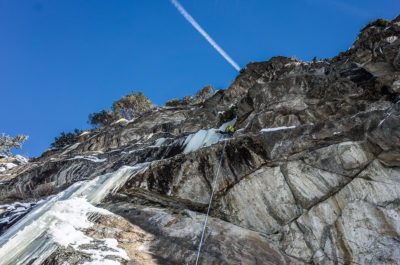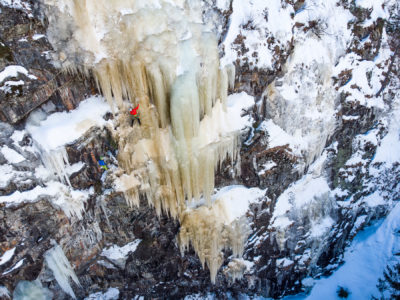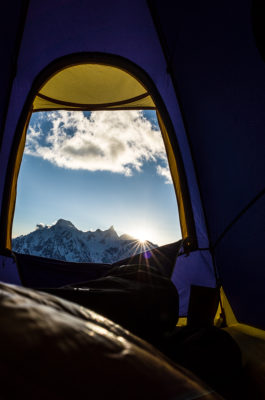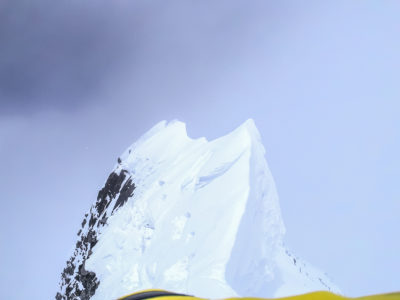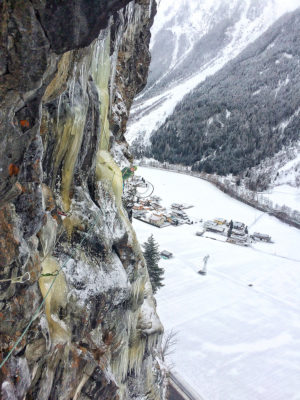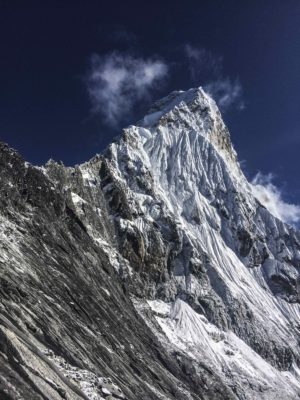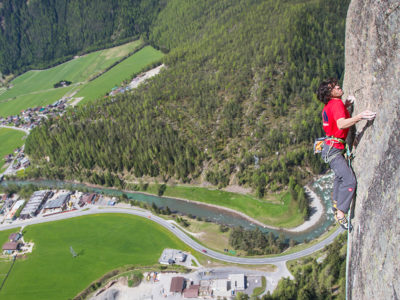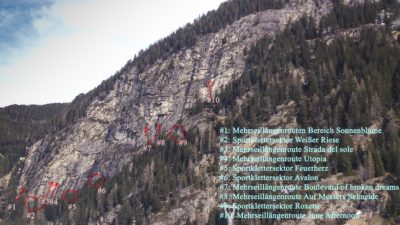20. September 2017
Nie hätte ich mir gedacht, dass ich einmal Autor eines Buches werde. Und immer wieder muss ich daran denken was gewesen wäre, hätte mich das Ehepaar Zander während meiner schwierigsten Free-Solo-Begehung Ende April 2007 nicht fotografiert. »Südwand«, so heißt es nun, mein erstes Buch. Es war ein langer Prozess, ein Aufstieg mit vielen Höhen und Tiefen. Ein Grat, der immer wieder unerwartete Überraschungen parat hatte. Aber Einer, der sehr viel Spaß gemacht hat. Eigentlich ist es schade, dass die Expedition nun vorbei ist, aber gleichzeitig freut es mich sehr, dass ich zu dieser Reise gestartet bin. Danke an alle die mich während der letzten drei Jahre des Schreibens immer wieder dazu motiviert haben. Viel Spaß beim Lesen.
Hansjörg Auer,
September 2017
SÜDWAND
Vom Free-Solo-Kletterer zum Profibergsteiger
Am 29. April 2007 bricht Hansjörg Auer allein in die Dolomiten auf. Nur seine Eltern und ein Bruder wissen, was er an diesem Tag vorhat: die ungesicherte Durchsteigung der Route »Weg durch den Fisch« an der Marmolata Südwand. Zufällig wird jedoch beobachtet, wie ihm dieser alpinistische Meilenstein gelingt. Und für den zurückhaltenden jungen Kletterer, der auf einem Bauernhof in Tirol mit vier Geschwistern aufgewachsen ist, beginnt damit seine größte Herausforderung: ein Leben im Rampenlicht der Alpinszene. Freimütig schreibt er in seinem Buch über die Sehnsucht, die ihn immer wieder zu solchen extremen Aktionen treibt: zu Free-Solo-Begehungen an den schwierigsten Wänden der Alpen oder zu einzigarten Routen an den höchsten Bergen der Welt. Er spricht über Selbstvertrauen und Glück ebenso wie über Angst und Egoismus; erklärt,
was mit einem Menschen passiert, wenn nur noch der eigene Weg für ihn zählt. Wie der Wunsch nach absoluter Kontrolle über den eigenen Körper zum völligen Kontrollverlust führen kann. Und warum Freundschaft nicht nur am Berg, sondern auch weit über das Klettern hinaus von größter Bedeutung ist. Dabei offenbart sich ein nachdenklicher und sympathischer Spitzenalpinist, der trotz seiner Erfolge am Boden der Tatsachen geblieben ist.
LESEPROBE
Starkes Storytelling
Die Frage, ob der traditionelle Alpinismus überlebt oder nicht, hängt weniger davon ab, ob und wie schnell klassische Bergtouren gelingen, als vielmehr von der Fähigkeit der jungen Generation von Bergsteigern, sich und ihre starken Erlebnisse auch auszudrücken. Der Alpinismus ist inzwischen eine globale Erscheinung, es wird auch viel besser geklettert als früher, und jede Disziplin, in die sich das Klettern und Bergsteigen aufgesplittet hat, hat ihre Spezialisten und Tabubrecher.
Es wird gleichzeitig aber immer schwieriger, wirkungsvolle Geschichten zu erzählen. Nicht etwa, weil alles gesagt wäre, nein, weil mit der Urbanisierung der Gebirge ihre Geheimnisse schwinden. Hansjörg Auer hingegen kommt immer wieder zurück von Bergen, die kaum jemand kennt – Kunyang Chhish, Nilgiri, Gimmigela, Shipton Spire, Kristallwand, Neacolas, Blåmann, Cerro Laguna, Jebel Misht –, und beschwört mit seinen Berichten die Launen der Natur. Wie ein Zauberer. Wenn er solo in den »Fisch« an der Marmolada d’Ombretta einsteigt, weiß er nicht nur, was er kann, er ist dabei für sich und danach für die Forterzählung der Kletterkunst verantwortlich.
Die alpine Geschichte ist die Summe aller am Berg erlebten Geschichten. Die daraus gefilterte Alpingeschichte bewegt Gesellschaft und Szene seit zwei Jahrhunderten. Eine erfundene Geschichte? Auch, zuerst wird erlebt, dann erzählt, in der Szene wird darüber diskutiert und analysiert, zuletzt setzen sich Bilder der Bergwelt durch, die die Menschenwelt erschüttern.
Der traditionelle Alpinismus, wie ihn uns Hansjörg Auer vorlebt, ist heute von den berühmten Bergen weggerückt in jene Wildnisareale, in denen Pistenbergsteiger und Speedkletterer nicht anzutreffen sind. Er ist mit seinen Partnern immer dort unterwegs, wo die vielen anderen nicht hingehen. Eigenverantwortung und Kreativität sind es, die ihn neben seinem Instinkt für die Wildnis und seinem Können die Herausforderungen der Jetztzeit finden lassen. Sein Spielfeld ist erstaunlich groß und lässt die verblüffendste Vielfalt von Klettereien zu. Mit seinen sachlichen Erzählungen darüber nimmt er uns Leser mit in immer menschenfeindlichere Welten, in denen die alpine Geschichte weitergesponnen wird. Seine Touren sind kein Fantasieprodukt, und doch leben sie in unseren Köpfen fort durch seine Erzählungen, die Teil unserer gemeinsamen Geschichte werden.
Es ist eine Tatsache, dass ein Großteil der Kletterer heute an künstlichen Wänden und markierten Routen steigt – ein großartiger Sport –, an den Seven Summits und Achttausendern werden Pisten gebaut, um Gruppenreisenden auf das Dach der Welt zu helfen – kostspieliger Tourismus –, solange aber Typen wie Hansjörg Auer Gefahren und Schwierigkeiten in absoluter Exposition aufsuchen und offen darüber berichten, bleibt der traditionelle Alpinismus lebendig und spannend zugleich. Eine endgültige Definition dazu gibt es nicht, sie entsteht allein in unserer kollektiven Vorstellungskraft – dank gelebter und erzählter Storys.
Reinhold Messner,
im Sommer 2017
Leidenschaft
Im Alter von sechs Jahren stand ich auf meinem ersten 3000 Meter hohen Berg. Ein ganz gewöhnlicher Wanderberg bei Umhausen, dem Ort, wo ich aufgewachsen bin. Drei Jahre später vermerke ich in meinem Tourenheft den Hemrachkogel. Zusammen mit meinen Brüdern Jakob, Matthias und meinem Vater sind wir wohl nicht über den Normalweg auf den Gipfel gekommen, denn in den letzten zwei Zeilen heißt es, dass wir auch ein bisschen klettern mussten. Zwei Ausrufezeichen beenden den kurzen und nüchternen Eintrag. Ich bin mir auch sicher, dass mein Vater uns damals den Strahlkogel, die höchste Erhebung von Umhausen, gezeigt hat. Nach allen Seiten fällt dieser Gipfel steil ab. Nach Norden ein kleines Eisfeld und eine steile, brüchige, gut 400 Meter hohe Wand. Damals war ich weit entfernt davon, sie klettern zu können, dennoch blickte ich zu ihr hinüber mit einer Sehnsucht, die mich über viele Jahre nicht mehr losgelassen hat.
Wenn ich heute diese Nordwand sehe, denke ich immer an die Stunden zurück, die ich damit verbracht habe, sie im Winter, im Sommer, allein oder zusammen mit meinen Freunden zu klettern. Es sind schöne Erinnerungen an damals und die ersten ans extreme Bergsteigen. Wir waren sehr motiviert und haben die Strahlkogel-Nordwand als Sprungbrett gesehen für die großen Herausforderungen, die großen Berge. Ich kann mich noch genau an das erste Mal erinnern. Es war im Sommer 2000. Mein Bruder Matthias war 18, ich gerade mal 16. Am späten Nachmittag sind wir mit Zelt und Schlafsack durch das Larstigtal aufgestiegen und haben am letzten grünen Fleck unser kleines Lager aufgebaut. Wir waren viel zu nervös, um den schönen Sonnenuntergang zu genießen. Früh gingen wir schlafen, und ebenso früh sind wir aufgestanden. Um sechs Uhr waren wir bereits am Einstieg und irgendwie enttäuscht, als wir schon kurz nach acht Uhr auf dem Gipfel waren. Wir hatten so viel von dieser Wand erwartet, waren überzeugt, wir müssten uns über viele Seillängen hinweg sichern, und hatten uns auf einen langen Tag im brüchigen Fels der schattigen Wand eingestellt.
Da sie meinem Bruder und mir im ersten Moment nicht sehr viel zurückgab, habe ich erst viele Jahre später den Wert dieser Wand, dieses Berges und des damit verbundenen Abenteuers für mich schätzen gelernt. Viele andere Wände lagen da schon hinter mir, viele großartige Tage, viele Überraschungen, aber auch einige Rückschläge und eine Tragödie. Die positiven Erfahrungen sollten jene von der ersten Durchsteigung der Strahlkogel-Nordwand noch übertreffen, aber auch die negativen werden mich mein ganzes Leben lang begleiten.
Heute steige ich immer wieder hinauf über unsere direkte Nordwandroute, sei es nach Neuschnee an einem kurzen Tag im November oder bei Firn und dem Duft der ersten Blumen am hinteren Talboden des Larstigtals im Mai. Und ich denke darüber nach, wie es gewesen wäre, wenn unser Vater nicht mit uns Buben an jenem Tag auf den Hemrachkogel geklettert wäre.
Nilgiri Süd
Damals, als niemand ahnen konnte, was die Zukunft bringen würde, und auch sonst nicht viel los war, sind wir mit dem Fahrrad gekommen. Und zwar zum Klettergarten Engelswand, der am nächsten gelegenen Klettermöglichkeit in unserer Gegend. Froh, die Schulprobleme für die nächsten Stunden hinter mir zu lassen, warf ich den Rucksack zu Boden, zog mir den grauen Klettergurt an und legte das Seil aus. Gerry Fiegl aus Umhausen, einer meiner ersten Kletterpartner und Freund aus der Trainingsgruppe des Alpenvereins, reichte mir die Kletterschuhe, und los ging’s. Meist habe ich mit der ersten Seillänge begonnen. Nicht, weil ich besser klettern konnte, sondern wohl eher, weil ich vier Jahre älter war. Wir sind immer in dieselben Routen eingestiegen. So konnten wir vergleichen, uns gegenseitig pushen und viel mehr voneinander lernen.
Einmal pro Woche waren Gerry und ich beim Klettertraining in der Halle in Tumpen. Und war einmal einer von uns verhindert, so sahen wir uns doch fast jeden Tag in der Früh, wenn wir zusammen mit dem Bus nach Imst zur Schule fuhren. Er ins Unterstufen-Gymnasium und ich zur Handelsakademie. Es gab also immer genug Möglichkeiten, sich zum Klettern zu verabreden. Zwei Jahre später wechselte Gerry dann auf eine weiterführende Schule nach Innsbruck. Unser Kontakt wurde lockerer, er verbrachte die meiste Zeit im Internat. Nur an den Wochenenden kam er wieder ins Ötztal, und auch wenn er inzwischen manche anderen Interessen hatte, war Gerry doch immer wieder dabei, wenn ich zusammen mit anderen Ötztaler Kletterern unterwegs war. Ich erinnere mich noch genau an ein verlängertes Wochenende im Tessin oder an Ausflüge in die Dolomiten.
Deshalb freute es mich auch, dass ich nach meiner Free-Solo-Begehung der Route »Weg durch den Fisch« die Möglichkeit hatte, Gerry als Testimonial bei einer Outdoorfirma unterzubringen. Er wollte nie wirklich Profikletterer werden, dennoch war er froh, dass er neben seinem Studium der Meteorologie in Innsbruck und all den anderen Ausbildungen, die er absolviert hatte, damit die Chance bekam, sich die Ausrüstung leisten und seine Freizeit noch intensiver für den Klettersport nutzen zu können.
Schnell hatte Gerry sein Können gesteigert, und zusammen sind wir in den folgenden Jahren viele neue Routen geklettert. Ganz besonders erinnere ich mich an die erste freie Begehung der »Colpo di Coda« an der Marmolata oder unsere Erstbegehung »Coco Jambo« gleich rechts von der »Don Quixote«. Aber auch im Ötztal waren wir sehr aktiv, sei es im Eis oder im brüchigen Fels der Kristallwand. Irgendwie hat Gerry sich immer die Zeit genommen, und an Motivation hat es ohnehin nie gefehlt. Und jedes Mal, wenn wir den Tag bei einem Bier, Kaffee oder aber auch einem kurzen Gespräch vor unseren geparkten Autos ausklingen ließen, redeten wir davon, irgendwann zusammen etwas Großes zu unternehmen. Im Herbst 2015 war es dann endlich so weit, und als unser gemeinsamer Freund Alex Blümel, Bergführer und Alpinist aus Mötz in Tirol, auch mit im Boot war, konnte die Expedition zum Nilgiri Süd starten.
Bestellung und mehr Info: hier
Blick ins Buch: hier
Erschienen am: 02. November 2017
Termine zu Präsentationen im Menüpunkt »Speaking«




